#geological society
Text
Palaeontologist Mary Anning (1799-1847) was known around the world for get Jurassic discoveries in the fossil beds at Lyme Regis. Her findings changed scientific thinking about prehistoric life yet she was not able to join the Geological Society of London. In her lifetime, her extraordinary finds were rarely published or credited to her, and she was paid little money for them. This portrait of Mary Anne her dog Tray, by Benjamin Donne, a neighbour, is a copy of an 1842 painting.

"Normal Women: 900 Years of Making History" - Philippa Gregory
#book quotes#normal women#philippa gregory#nonfiction#palaeontology#mary anning#jurassic#fossil beds#fossils#lyme regis#prehistoric life#scientific discovery#ineligible#sexism#geological society of london#dog#benjamin donne#copy#40s#1840s#19th century
6 notes
·
View notes
Text
Book 44: The Map That Changed the World
RNG put me in the 500s, and I kinda forgot to go deeper so I ended up with general science books. There were a ton of all time greats, but I ended up with Simon Winchester's The Map That Changed the World.
This book was about William Smith (1769-1839) a groundbreaking geologist who started out as a surveyor/coal mine manager/canal builder/land drainer. He made the first large-scale geological map in existence. Even after listening to the book twice I'm not entirely sure what the rock he mapped out was, I mean, there are lots of layers of rocks under places, right? I guess it was the type of rock just under the surface of the ground? Anyway, it is considered by many to have birthed the science of geology and kickstarted investigations into the age of the Earth, etc.
William Smith himself had a hard life, his blacksmith father died when he was a child and his mother abandoned him to his cheapskate uncle who Smith had to borrow against his inheritance to get basic reference materials that would further his career as a surveyor. Eventually he ended up in debtors prison after some speculation went wrong and spending on making his extensive geological map. He was prevented from joining the prominent Geological Society by a rival who also made a rival map that stole from Smith's and cut into his sales which landed him in the debtor's prison (Wikipedia disputes this as the rival map came out after Smith landed in jail, but this book shows how anticipation of the rival map cut into his sales, not just when the map finally came out.) Smith's map was championed by our old friend Joseph Banks of the ever-present-in-these-books Royal Society.
Should you read this book: Sure, it's interesting and has lots of good facts about the life of William Smith and life and science in the 1700s-1800s. The author is a bit British, throwing around names like Boswell as if we all know him offhand here in America (I know him, just not offhand).
ART PROJECT: It was kind of impossible to not do the map, and I thought I'd laser burn it then hand color it, but it turns out I don't have the patience to hand color it like William Smith did. So here it is laser burned anyway.

#william smith#joseph banks#royal society#geology#geological map#52books#52booksproject#dewey decimal system#rng
9 notes
·
View notes
Text

Field Trips in the Southern Rocky Mountains, USA, edited by Eric P. Nelson and Eric A. Erslev, from The Geological Society of America, 2004
From my local thrift store
#Field Trips in the Southern Rocky Mountains#my library#Eric P Nelson#Eric A Erslev#The Geological Society of America#2004#2000s#rocky mountains#southern rocky mountains#geology#geology book
1 note
·
View note
Text

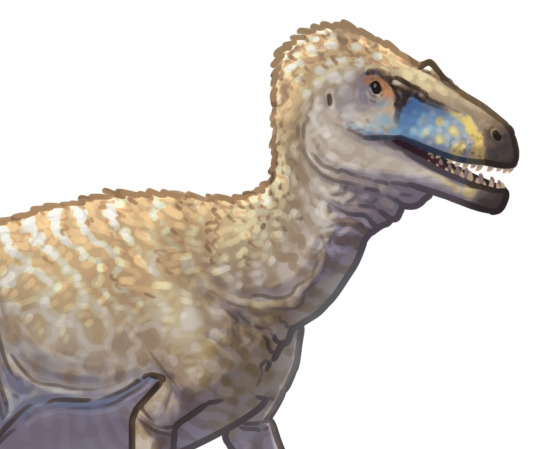

Happy 200th birthday to Megalosaurus bucklandii!!!
On the 20th of February, 1824, English palaeontologist William Buckland announced a discovery at a meeting of the Geological Society of London. The fossil jawbone, several vertebrae, pelvis and limb elements he presented that day belonged to a creature unlike anything seen before: a gigantic, land-living carnivore to which he gave the name Megalosaurus, the "Great Reptile".
This announcement, including an official published description of the fossil remains, was the first of three named species that in 1842 would be collected together by Richard Owen into the group Dinosauria. This makes Megalosaurus, revealed to the world on this day 200 years ago, the first Mesozoic dinosaur to be scientifically named!
Over the years Megalosaurus has been through some ups and downs, from being the most famous dinosaurian predator to being a wastebasket taxon that basically every scrappy theropod fossil was assigned to, to slightly fading into obscurity as more spectacular finds take the spotlight. But through it all the legacy it holds as the dinosaur that kicked off this whole wild 200 year train will always be unique.
So congrats to Megalosaurus on 200 years of being a truly Great Reptile!
647 notes
·
View notes
Text
Canadian foundation engineering manual pdf
The geotechnical engineering profession in Canada is in the process of
La quatrième édition a été publiée en anglais (sous le titre de Canadian Foundation Engineering Manual) en 2006 et en français, en 2013.
</p><br>https://jacimikaqi.tumblr.com/post/693877335346348032/ios-4-ipad-mode-demploi, https://jacimikaqi.tumblr.com/post/693878704526557184/lubitel-166-universal-mode-demploi-iphone, https://jacimikaqi.tumblr.com/post/693878070672801792/manuel-peugeot-fox, https://jacimikaqi.tumblr.com/post/693878704526557184/lubitel-166-universal-mode-demploi-iphone, https://jacimikaqi.tumblr.com/post/693878070672801792/manuel-peugeot-fox.
#http://vk.cc/c7jKeU#nofollow#<p> </p><p> </p><center>CANADIAN FOUNDATION ENGINEERING MANUAL PDF >> <strong><u><a href= rel= tar#<br>#<br> </p><p> </p><p> </p><p>Site Evaluation – Baseline Data – Baseline Geological#Geotechnical#for the foundations of a facility (Canadian Foundation Engineering Manual#2006).The Canadian Foundation Engineering Manual is published by the Canadian Geotechnical Society. The 4th Edition was released in English#The 2005 National Building Code of Canada (NBCC 2005) mandated the use of limit
0 notes
Text
Shoutout to me for forgetting the muscu more popular use of the acronym gsa (gay straight alliance) and thinking only of the gsa (geological society of America) thereby confusing everybody else
#my friend was like well we went to that one gsa meeting right#and I was like hmmmm well I don’t think it was gsa#and they’re all like ????????#and I have to be like ahhh… you do not mean the geological society of America
0 notes
Note
So in my fantasy setting, magic not only doesn't work on iron, but applying it immediately nullifies any spell upon contact. This means that iron, in a setting with a lot of beings made of magic, is the one universal weakness that can easily kill them. Naturally, considering the fact that we're talking about a world overrun with them that are not afraid to eat people, this means societies tend to form around veins of iron ore (that's the right word, vein, right?) and are naturally going to be much more inclined to crafting iron weapons to deal with the magical beings wanting to eat people.
However, it was in thinking through that only pure iron weapons are what give iron its power that I run into issues. Considering that means steel is effectively blocked off when it comes to weapon making and magical enchantments don't work on iron here (though they do work on other kinds of metal), how exactly might that impact the tech tree on weapons in my setting? As well as anything else I might not have thought of when writing this? Thank you!
I poked at a similar thought process awhile back, and there's some problems I never fully worked around.
The problem with, “iron, but not steel,” is that, when you really get down to it, steel is just purer iron.
Let me put this another way, you're wandering around in a fantasy world that is geologically similar to our own, with similar metallurgy to 12thcentury Europe. An iron weapon you find will be mostly iron with some trace amounts of other metals such as nickle, copper, and whatever else didn't get filtered out.
In contrast, if you get your hands on a steel weapon, that's going to be almost exclusively iron, with a little carbon, maybe some phosphorus or sulfur. (There's a fairly long list of elements you can find in trace quantities, but this is also true of normal iron weapons.) The important thing to understand is, iron weapons are made from iron, steel weapons are made from better iron.
Even as far back as the first millennium, some smiths were intentionally purifying their iron to produce higher quality weapons (including the first super alloys, such as Damascus steel.) But, it was still iron.
Really, the one kind of iron you're likely to find in that world that isn'talmost exclusively iron would be meteoric iron. This is, as the name implies, iron that came from a meteor strike. In these cases, you're actually looking at a significant amount of nickle (usually 5-10%), along with a bit of cobalt and traces of a mix of other elements.This stuff was used in weapon making, but was extraordinarily rare. As a weapon, meteoric iron isn't incredibly useful, it's still inferior to steel weapons, but it will resist corrosion, and can make for a very showy weapon. This, in turn, can result in a weapon that appears to be somewhat magical, and may be while, “starmetal,” “starsteel,” or meteoric iron is a semi-popular material for magical weapons.
So, if the issue is iron itself, then there's no chemical reason steel shouldn't also function. Of course, that does nothing to eliminate potential mystical or supernatural explanations, but if this is a magical vulnerability, you're not going to find an answer in chemistry.
This leads to two possibilities. I'm going to use orichalcum as an arbitrary example, if you're unfamiliar, this was a metal Plato claimed was mined on the isle of Atlantis, and was the foundation for their economy, but you'll frequently find this brought up in fantasy without any connection to that original context.
So, either your world is one where human on human violence is conducted with something other than (and superior to) iron and steel, for example: Orichalcum, and that creates a situation where using steel weapons could actually put fighters at a disadvantage against properly equipped troops.
Alternatively, it's possible that, while iron and steel are marginally effective against monsters, there are other, much rarer, possibly irreplaceable, materials that are far more effective. In this example, it's possible that there are no sources of raw orichalcum remaining in the world, and the artifacts that have been mined and forged are all that is left. To make matters worse, it's possible that no living smiths have the knowledge to forge (or reforge) these weapons, meaning that any damage to these items is irreparable.
For an amusing twist on this, if titanium was the metal needed to harm monsters, that would create serious issues. The problem is, you cannot mine titanium. It's impossible (at least on Earth.) This is because titanium does not naturally occur as a metal, and only as an oxide (a white powder), and it wasn't until 1910 that the first metallic titanium was produced in a lab. It would be over 20 years before a process was discovered to produce it on an industrial grade. If your setting is built off of a distant apocalypse, it's possible there would be weapons produced from this material, but there would be absolutely no way to get more, while still having a veneer of chemical plausibility. (Alternately, it's possible some alchemist in the past developed a method to produce titanium in your setting... and they may or may not still be around, with the weapons being extremely difficult to produce, or signs of a lost technology.)
Actually, a fun side note, chemistry comes from the same root as alchemy, and it's a case where a pseudo-mystical field transitioned into a hard science over time.
Now, don't consider this part an indictment, but, a couple years back, I remember watching someone's, how-to: world-building on YouTube, and they blasted the concept of the, “trade city,” as semi-nonsensical. The issue is that basically any city will get its start based on trade, and really, cities live and die based on their economies. So, when you say, “this city started as a trade city,” yeah, that's how you get a city. It's the rare cities that are founded for some other reasons (like a massive fortress that gradually accumulated a civilian population of people fleeing from beyond its walls, and adventurers or crusaders using it as a last stop before moving on into the wastes, with the city, and its trade economy growing due to factors unrelated to its usefulness as a trade port.)
Now, if you're wondering how this is relevant to your question, this is about the distribution of iron. There's some discrepancies between the largest iron deposits in the real world and the distribution of people, but access to iron was a critical consideration in the development of Western Europe. Or, put another way, if you have iron mines in the hills, but farmland and a river in the lowlands, you'll probably build your city in the lowlands, on the banks of the river, and then export whatever iron and food you don't need in exchange for other goods that you do find useful. It doesn't, really, matter much if there are ravenous hellbeasts wandering the foothills, if you can dispatch them with iron weapons. All that really means is you'll have slightly less iron to export. This creates a situation where settlements may range pretty far the iron mines, if there are other economic resources worth extracting. Trade would more heavily favor access to iron than in real world history, but it's not a completely alien scenario. In some ways, this isn't that different from a continent in a permanent state of total war, the only difference is that the monsters don't need their own iron supply lines. Settlements would need to be guarded, mines, farms, and other resources would also need protection. Trade lines would need guards. The overall level of fortification may be higher than in real history (though, this isn't a certainty), but a lot of the same considerations wouldn't be affected.
Now, on a grand scale, persistent hunting by supernatural monsters would amount to a greater economic drain than witnessed in real world history. This would slow some technological, and economic growth. I'd say that cities would, likely, be more fortified, but when looking at medieval cities, I'm not sure that would be the case. I'm also not certain this would meaningfully shift the balance of power (assuming an alternate history), simply because those monsters would hit everyone roughly equally. (Though, if the monsters do play favorites, that could heavily skew the balance of power.) While access to iron would be critical, access to other trade goods such as salt, clay, grains, and other things would still be useful. The best iron mine in the world won't keep your troops fed on its own.
I doubt you'd see a situation where iron became the dominant currency metal, and too valuable to waste on coinage. You would probably still see gold and silver as the dominant metal coinage, and that would also result in some geographical skewing, as there would be some settlements built around mining gold or silver, and then selling those materials to others in exchange for iron. It's also worth remembering that for a large part of the middle ages, most coin based transactions took place at the upper echelons of society. The barter economy would still be going strong in most fantasy settings. When talking about roleplaying game settings, that does get a bit warped, as players tend to swing around extraordinary amounts of wealth.
The biggest changes I'd expect would be slightly more terra nullius. If the plains between two mountains have no mineral wealth, and the mines on either side are already well supplied, there wouldn't be much reason to settle there. You might also see a move away from river travel. Historically, this was an extremely efficient way to move large amounts of resources, but if there are monsters in the water that pose a real threat to brown water shipping, that could cause some significant changes. Settlements might be more isolated from one another initially, until technological development got to the point where overland shipping (by cart) became more viable. It might also reduce the scope of trade overall, meaning situations like the gold mining settlement above, wouldn't be able to import enough food and iron to be viable. This might also inflate the value of other, secondary, goods. For example, access to limestone deposits large enough to effectively quarry, might become a defining factor on where fortified settlements can be built. If there isn't enough limestone on site, there simply might not be a way to effectively transport more. Even if it was only 20 miles from the settlement.
At the end, how much would it change the world? I don't know. There's a lot of factors which could heavily skew how the world shakes out. It could be almost non-existent, or it could be an entirely alien world. It depends on how much pressure your monsters apply to the world.
-Starke
This blog is supported through Patreon. Patrons get access to new posts three days early, and direct access to us through Discord. If you’re already a Patron, thank you. If you’d like to support us, please consider becoming a Patron.
303 notes
·
View notes
Note
What kind of wildlife is around in the Spirit World/Realm? The show had riding boars and river fish that I can remember, and if they grow things then the right kinds of little bees and gnats must be Around, but Just Those don't make for a full healthy environment, right?
We don't see a lot of animals in canon because animals are rarely a problem that shinigami have to deal with but some notes:
Thylacalines are not extinct in the spirit world! Actually, it's kind of a problem- Thylacalines will ONLY reincarnate as Thylacalines, and since there are none on earth, the entire peak population of them lives in the southern Rukongai. This is a problem unique to Thylacalines, as most extinct animals will reincarnate as other extant animals or humans or whatever, but nope. Not these assholes. Furthermore, killing a thylacaline in spirit world just makes it respawn elsewhere in the spirit world, as it was and with it's memory intact and those motherfuckers hold GRUDGES.
They're also not native to any of the places the human souls in Soul society come from so nobody has a damn clue what they're doing here. Well, they know what they're doing- Mostly eating anything that will fit in their mouths and occasionally mauling people who don't respect their personal space- but why they're doing that HERE is unclear.
The Migratory Bird Act of Year 1066 was established shortly after the Seki-Seki stone wall and spirit barrier surrounding the Seireitei was established, and within the week, catastrophic numbers of birds died flying into the invisible barrier. The act was actually spearheaded by Yamamoto, who was immensely distraught by the unintentional carnage, and had to actually threaten the Central 46 with bodily harm to get them to legally change the Kido spell on the barrier to only block Sapient Souls and let the birds come and go as they please.
It was a landmark legal case that established the soul society's remarkably robust environmental protections, and the Central 46's policy of isolation from the Shinigami, which would prove disastrously fatal to the organization almost 1,000 years later.
Many creatures we have on earth exist in Spirit world, but at massive Scale and varying degrees of intelligence. The Nago Boar was a wild boar of average porcine intelligence, but spectacular scale- 15 feet tall at the shoulder and many tons in weight. It was an infamous monster that made the Nago region borderline uninhabitable from it's rampages. It was one of the rare animals that became the problem for the Shinigami, who tried in vain to kill the beast for the better part of two centuries but unlike a Hollow who acts on instinct and has a very breakable mask, the boar was quite cunning and ended up with three zanpaktou lodged in it's cranium to no ill effect before the Gotei-13 decided to just pay the remaining farmers to leave in 1219.
It was slain by a hired swordsman protecting a geological survey in 1308, and the battle was immortalized in the Epic Multi-scene Screen Painting "The Slaying of The Nago Boar" by Minami Zasso, who was working as a surveyor and illustrator when he witnessed the event firsthand. The swordsman in the painting is unnamed, but there is a persistent rumor that the distinctive facial scar of the unnamed swordsman matches that of Eleventh Division Captain Zaraki Kenpachi, but that would mean the man is at least 700, more likely over 1000 years old! Surely not!
The Eleventh Division has another peculiar association with an animal of ridiculous scale. In 1272, the annual "Ranking Day" tournament (in which the members of the 11th division and anyone bold enough to take part would battle for ranked positions in the division- including the right to be captain) took place outside the Seireitei in a relatively isolated area of the rukongai because 1271's Ranking Day had turned into an outright riot that destroyed part of the city.
The commotion and blooshed attracted the attention of a supernaturally large Monitor Lizard, who joined the fray without hesitation, and devoured the 4th Kenpachi. Having met the requirements of "Defeat the standing captian in combat in front of 200 witnesses", and because nobody was brave enough to remove the captain's haori from where the lizard had become entangled in it, Tokagero Kenpachi was named the 5th captain of the 11th division.
Tokagero Kenpachi remained captain of the 11th division for an astounding 234 years, the longest reign of any Kenpachi, and via highly suggestive hissing and occasionally eating people she disagreed with, lead several important reforms within the division like "Pants Required" and "No showing up to work drunk" and "instituting the first 5-day work week and successful labor strike in Soul Society" though that last one was mostly the work of her long-suffering lieutenant, but her apparent taste for strikebreakers certainly helped the cause.
Tokagero Kenpachi was lost in the infamous Tonsure Riots of 1606 when she vanished down an open manhole cover and into the sewers. No body was ever recovered, and her wherabouts remain unknown to this day.
291 notes
·
View notes
Photo

Geologic Map of South America - The Geological Society of America / The American Geographical Society / USGS - 1950
by @geo_spatialist
2K notes
·
View notes
Text
something i saw once that has stuck with me ever since was a comment on a post about some scientific discovery made by the mars rover perseverance that said "why are we wasting time looking at rocks when we should be preparing for colonization?
another comment was on a post about the environmental issues surrounding the spacex launch site in southern texas, which said "human expansion to mars delayed to protect some turtles"
and comments like these perplexed me. space is a subject of science, and people interested in space are always talking about the wonders of the unknown, and how many fascinating and beautiful things are out there. so how could people interested in space be so fundamentally uncaring and incurious not only about the places they're supposedly interested in, but about nature in general?
it's not just random people in twitter replies who are like this. elon musk once posted this picture:

thing is, that's not mars, that's the moon during a lunar eclipse (when sunlight tinted red after passing through earth's atmosphere lights up the moon in earth's shadow). you'd think that someone known for wanting to bring people, himself included, to mars would care enough about mars to at least know what it looks like, but apparently not
he also rather infamously says he wants to nuke the ice caps of mars to warm the planet up. the ice caps of mars look like this, by the way (image credit: ESA/DLR/FU Berlin/Aster Cowart):

they are beautiful places, that hold an irreplaceable scientific record of the geologically recent martian climate, and are shaped by unique processes. there's no other place quite like them in our solar system. but elon musk thinks we should nuke them. again, no care, no curiosity
nothing has made me feel jaded and cynical about the entire enterprise of spaceflight quite like learning that the people ultimately in charge of it and funding it don't give a shit about space. it's not just elon musk. space nerds love quoting kennedy's "we choose to go the moon" speech as inspiration, but kennedy is also on record saying "I'm not that interested in space" in a conversation where he was arguing to the nasa administrator that they should prioritize beating the soviets to the moon over space science. no curiosity, only a desire for geopolitical showmanship and maintaining hegemony. it's the same thing when many modern politicians only seem to care about space exploration as a way of keeping a technological lead over china
this leaves the people who do genuinely love and care about space in an awkward position. they basically have two choices: A) become jaded and give up on space exploration, or at least parts of it (abandoning human spaceflight but maintaining interest in robotic science missions, for example) or B) give in. work with military contractors. spout the jingoistic rhetoric that the politicians writing the checks want to hear, even if you don't believe it. go along with the colonialist ideology, the hypercapitalism, and the extractivism. sell your soul for pictures of mars and let your passions be exploited for the ends of powerful people who don't care
the sad reality is that our society only values those things deemed useful or profitable. we hear it all the time. the idea that schools should only teach things useful for jobs, that people who try to make a living in fields like art, the humanities, or philosophy are all getting useless degrees and will inevitably end up stuck working retail, and of course, the idea that space exploration is a waste of time and money
space nerds are often deeply insecure about their greatest passion, because it's true, space exploration offers no immediate practical benefit. but they still love space and want to explore it
so they believe the lies. they repeat the colonialist ideology. they say there's money in mining asteroids, that we can terraform planets and let number go up forever. they let themselves be exploited by companies and governments that see everything in the universe and all the people in it as things to be used, and that will ultimately chew them up and spit them out if it's expedient to do so. and those who reject the ideology and keep their love for the cosmos pure often find themselves with no place in the project of space exploration
i don't know how to fix this, but i do hope that i will live to see the day when our curiosity and interest and love for the wider universe is valued for its own sake, and no longer shackled by colonialism, capitalism, and political ambitions
83 notes
·
View notes
Text
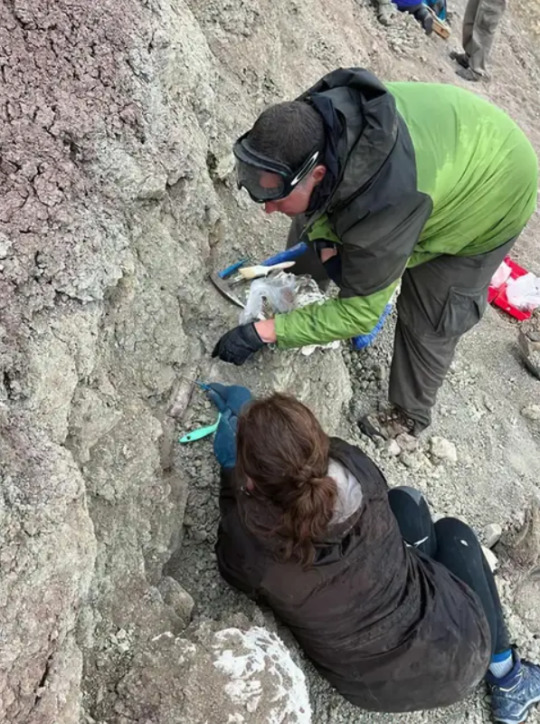

[ Photos by Derek Fikse and Kara Fikse, showing field team members working at the Cañadón Tomás Quarry. ]
"The discovery of a spectacular fossil site in Argentina is helping shed new light on life at the end of the Cretaceous, the time period just before the non-avian dinosaurs went extinct. New research recently presented at the Geological Society of America’s GSA Connects 2023 meeting by Matthew Lamanna, a paleontologist and the principal dinosaur researcher at Carnegie Museum of Natural History, describes exciting fossil finds from a site known as the Cañadón Tomás Quarry in southern Argentina’s Patagonia region.
“In general, dinosaurs and other continental vertebrates from the Cretaceous tend to be less known from the Southern Hemisphere than they are from the Northern, and that creates an imbalance in our understanding of biodiversity, evolution, and paleobiogeography,” says Lamanna. “We know enough about continental vertebrates in the Late Cretaceous to know that there were some very different kinds of animals thriving in the Southern Hemisphere. One thing that we’d really like to know is, how did non-avian dinosaurs in the southern half of the world fare at the Cretaceous-Paleogene boundary?”
The Cañadón Tomás site was first discovered in early 2020 due to petroleum interest in the region. Oil companies were required to carry out a paleontological impact study before they could begin work, and the study soon uncovered dinosaur fossils."
Read more: "A Glimpse of Extinction: Scientists Uncover Extraordinary Fossils From the End of the Age of the Dinosaurs" from the Geological Society of America.
#Palaeoblr#Palaeontology#Paleontology#Argentina#Fossils#Dinosaurs#Cretaceous#Mesozoic#Article#Prehistoric#Information#Photos
90 notes
·
View notes
Text
Get ready to say goodbye to a lot of familiar bird names, like Anna's Hummingbird, Gambel's Quail, Lewis's Woodpecker, Bewick's Wren, Bullock's Oriole, and more.
That's because the American Ornithological Society has vowed to change the English names of all bird species currently named after people, along with any other bird names deemed offensive or exclusionary.
"Names have power and power can be for the good or it can be for the bad," says Colleen Handel, the society's president and a research wildlife biologist with the U.S. Geological Survey in Alaska. "We want these names to be powerful in a really good way."
The move comes as part of a broader effort to diversify birding and make it more welcoming to people of all races and backgrounds.
"We've come to understand that there are certain names that have offensive or derogatory connotations that cause pain to people, and that it is important to change those, to remove those as barriers to their participation in the world of birds," she says.
The project will begin next year and initially focus on 70 to 80 bird species that occur primarily in the United States and Canada. That's about 6 or 7 percent of the total species in this geographic region. (Read more at link)
As a birder, I like the idea. Descriptive names are helpful in birdwatching. And as the article explained, some names have already been changed like a longspur named after a confederate general. It's not like the birds care what they are named, any preference for current names is just sentimentality on our part.
96 notes
·
View notes
Text


6,000-Year-Old Sandals Found in a Spanish Cave are Europe’s Oldest Shoes
New analysis has identified the oldest shoes ever discovered in Europe, according to a study published this week in the journal Science Advances.
The 22 woven sandals date from 6,000 years ago, radiocarbon analysis found in the study led by researchers at the Autonomous University of Barcelona and Alcalá University in Spain.
The ancient footwear, along with Mesolithic baskets and other tools, was first discovered back in 1857, when a cave in southern Spain was looted by miners. However, when the artifacts were first dated, in the 1970s, they were identified as being about 1,000 years more recent than this latest analysis found.
The very dry conditions within the cave were ideal for preserving perishable materials, the researchers said, and allowed the preservation of a prehistoric burial site complete with partially mummified corpses, accompanied by baskets, wooden tools, sandals and other goods.
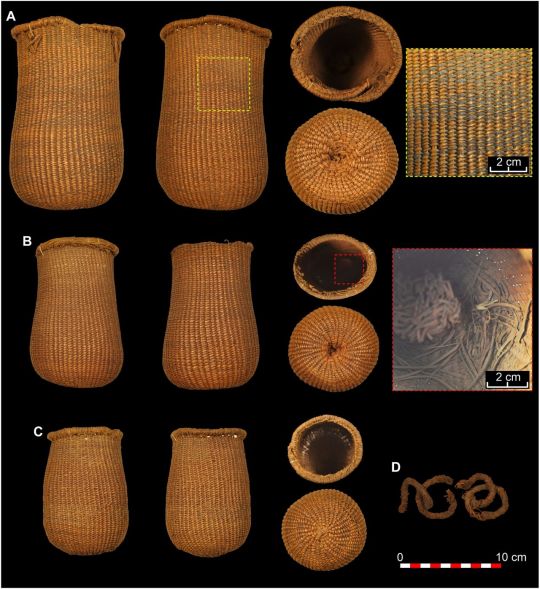

The objects are “the oldest and best-preserved set of plant fiber materials in southern Europe so far known,” María Herrero Otal, one of the study’s authors, said in a statement, adding that they demonstrate “the ability of prehistoric communities to master this type of craftsmanship.”
When Spanish archaeologist Manuel de Góngora y Martínez visited the cave in 1867, 10 years after the looting, he gathered the remaining artifacts, including the sandals, and gave them to museums in Madrid and Granada, where they have been studied by researchers, the study added.
The sandals were made of grasses as well as other materials, including leather, lime and ramie bast, a type of natural fiber.
Using the descriptions provided by Góngora, the study hypothesizes that the bodies were buried wearing the sandals.
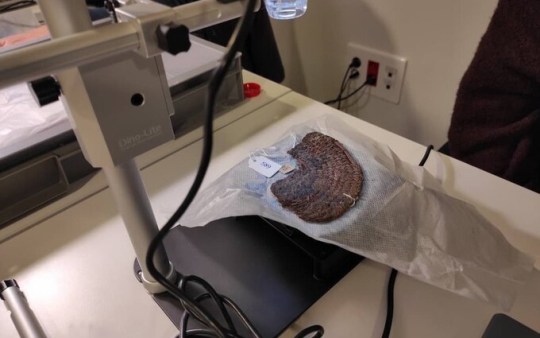
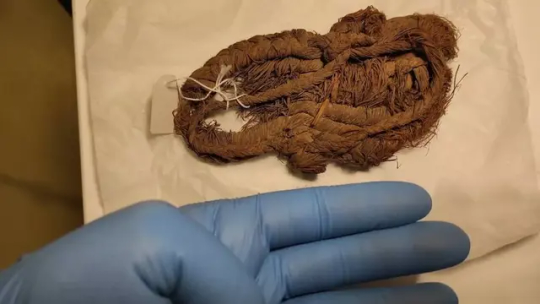
Some sandals had clear signs of wear, while others appeared never to have been worn, suggesting that some people had clothing made especially for their burial.
The researchers also studied several baskets and other wooden artifacts in the collection. These objects “open up groundbreaking perspectives on the complexity of Early-Middle Holocene populations in Europe,” they said, adding that most knowledge of past societies is drawn from durable artifacts rather than perishable ones such as baskets. The Holocene is the current geological epoch, which began 11,700 years ago.
Both the baskets and sandals suggest that the makers had an extended knowledge of the plant resources in the local environment as well as a high level of expertise, the researchers noted.
“The quality and technological complexity of the basketry makes us question the simplistic assumptions we have about human communities prior to the arrival of agriculture in southern Europe,” Francisco Martínez Sevilla, one of the study’s authors, said in a statement.
The study also found that the objects were deposited at the site at two very different times during the Early and Middle Holocene eras. The first phase was related to the Early Holocene hunter-gatherer populations, and the second phase to Middle Holocene farmers, researchers said.
By Issy Ronald.


#6000-Year-Old Sandals Found in a Spanish Cave are Europe’s Oldest Shoes#the oldest shoes ever discovered in Europe#Cueva de los Murciélagos#the Cave of the Bats#Andalusia Spain#ancient artifacts#archeology#archeolgst#history#history news#ancient history#ancient culture#ancient civilizations
128 notes
·
View notes
Note
I’ve just completed your most recent chapter and what a delight it was from start to finish. The slow burn continues to be delicious, and you’re doing an amazing job of gradually adding bits of kindling to the flames to keep DHr’s relationship progressing (and to feed us readers). This most recent chapter was a textbook definition of fic that gets me giggling and kicking my feet.
I’m always amused by our sweet Victorian child Draco’s reaction to sex, and the reference again to sheets and friction sent me. I’m pretty sure this isn’t the first time Draco has been nearly undone by his bedding, and it got me thinking about Pureblood culture’s views of sex and intimacy.
I know oftentimes in fanon, we tend to get Slytherin sex god/goddesses who are having their first sexual experiences pretty early, though occasionally we get a more prudish/Puritanical Draco. We know in Lionheart’s universe, Narcissa alludes to a certain level of hanky panky with Lucius in the RoR, and it certainly seems like Draco had imagined any number of acts with Hermione, even if he hasn’t acted on them in public or perhaps even privately.
If it’s not spoilery, I’d love to know more about how Pureblood culture in Lionheart generally views sex/intimacy, especially inside/outside of courtship and marriage.
It's a mixed bag! I think the Slytherin sex gods thing is a kind of wish-fulfillment (loving compliment) because, put bluntly, the number of 15-17 year-olds who are even kind of charitably good at sex is a mathematical rounding error. Also, Hogwarts has group dorms. Sexiling one person in college is hard enough; imagine you have to sexile (i.e., declare publicly your intent to fuck) 3-5 people every time you want to mess around. I'm not saying it doesn't happen, it absolutely does — it's a coed boarding school, you can't fight the wind — but I will say it's probably more at the realistic level of high schoolers fumbling through the excruciating ordeal of learning intimacy, and not "the plot of Euphoria is happening in the dungeons at all times."
Anyway. I interpret the wealthier pureblood set as a kind of wizarding aristocracy, so while in general they're expected to perform to certain expectations and social mores when they're in social/public settings, the fact of the matter is it's the twentieth century and sexual mores are changing a LOT from decade to decade. Narcissa's upbringing would have been radically different from Draco's in terms of how much sex and intimacy would have been open subject — in no small part because Narcissa's generation kind of blew the ceiling off that particular conversation. She was born in 1955 and lived through the Sexual Revolution, meaning that her childhood, adolesence, and young adulthood took place in practically three different geological eras of social life. Meanwhile, women like Walburga and Druella were members of the Greatest Generation (maybe Silent Gen on the younger side), and would've been incredibly traditionalist.
Of course, no matter what the social rules are, teenagers will find a way around them. For the purposes of Lionheart, in 1995, it's understood by most pureblood parents that kids are gonna do what kids are gonna do, but there are specific standards about who you can be seen with and make certain kinds of promises to. Narcissa kind of references this at the end of book 3; she goes on this insulting little spiel about how generations of Blacks and Malfoys had secret muggle-born pets that they kept on the side, they just didn't bring them to dinner parties. Basically, what you do in the privacy of your bedroom is your own business; just don't get caught and don't try to push boundaries, and your social set will be understanding, up to a point. But it would be absolutely improper for "dating" or "courting" to take place between a muggle-born and a pureblood, because that expresses the intent to associate with them in Society, which is a discrete sphere with its own set of rules — one of which is that you have to enforce the caste system.
With respect to specific mores and rules, there's a few references to "etiquette." That stuff's inspired by real etiquette manuals from Victorian and Edwardian England, though I've occasionally thrown in my own twist when it suits me. Dance with the one that brought you; you should have an escort to balls, theoretically but not necessarily someone you're interested in; women run the household, men run the estate. There are certain standards of chivalry and respect on the men's part, but there are also standards of ladylike conduct and decorum on the girls'. Daphne is shocked when Katie wears a suit to the Ball— to the point where she's like "?? ARE you a girl?" — because the rules of dress and poise have been so drilled into her. The level of slut-shaming we get from the Slytherin girls (despite several Slytherin girls being sexually active) also indicates how female sexuality is policed in a way male sexuality isn't; the rumors about Draco and Daphne hurt Daphne, not Draco. This double-edged hypocrisy runs hand in hand with the idea that women are training to be wives, and shouldn't be sleeping with people (if anyone) who they're not seriously pursuing for marriage. Relatedly, courting/engaged couples are usually seen together, a la Crabbe and Millicent, because the idea is you're supposed to be preparing for your marriage; now that you're socially connected, you've begun your tenure as a Unit, and you're expected to act like it. It would be strange for Vince or Millie to go to a ball with someone else unless that partner was a relative or (possibly) a close family friend. It would... imply something.
Marriage between a man and woman would be expected, not because purebloods on the whole are traditionalist — which, to be clear, they are — but because the emphasis on bloodlines means children are a priority. Pansy gives us the best précis on this in Book 2. Blaise, being gay, is in an interesting place vis-a-vis the marriage question because his position doesn't come from being heir to an old estate, it's from his mother's money; in that respect, he's not bound by usual expectations of hereditary legacies, which is possibly why he's comfortable being out. (Although there's a blink-and-you-miss-it remark about some tension with his mom in "Miseducation.")
#in retrospect that moment with daphne is so funny to me#tfw your social rules are so intense you spontaneously invent the idea of being nonbinary to explain why Girl But Not Skirt??#and find that (to your understanding) completely novel concept more plausible than a girl just wanting to put a suit on#anyway. this is just incoherent rambling about sex and marriage and stuff#I hope it's half interesting!#lionheart spoilers
27 notes
·
View notes
Text
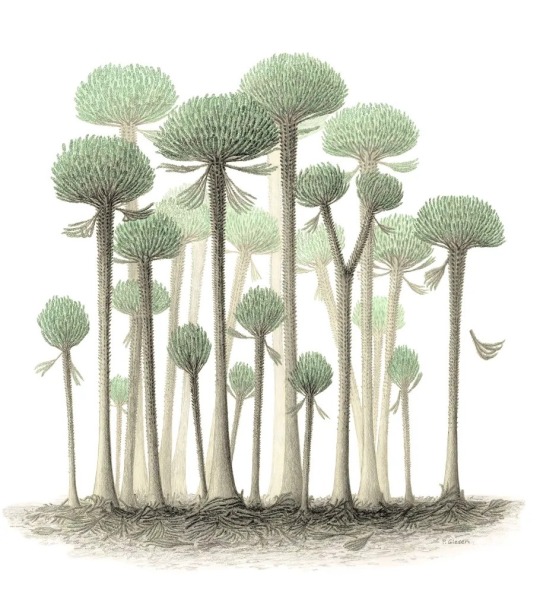




🇬🇧
Scientists in southwest England have recently unveiled the discovery of the oldest fossilized forest known on Earth, dating back an astonishing 390 million years. This finding, detailed in a new study released by the University of Cambridge, surpasses the previous record held by a forest in the state of New York by 4 million years.
The fossils were found on high sandstone cliffs on the south side of the Bristol Channel, near Minehead, close to a holiday park. The trees, identified as Calamophyton, bore resemblance to palms, although their trunks were thin and hollow, devoid of leaves but with branch-like structures covering their branches. These trees ranged in height from 2 to 4 meters, losing branches as they grew.
The forest dates back to the Devonian Period, a critical time between 419 and 358 million years ago when life began to venture onto land. The trees played a vital role, trapping sediments in their root systems and stabilizing riverbanks and coastlines.
The study also highlights the rapid evolution of primitive forests. While the English forest is less diverse, consisting of only one tree type compared to New York's oldest forest, which housed a variety of species, it demonstrates how flora changed quickly in geological terms.
Additionally, these trees provided habitats for ground-dwelling invertebrates, leaving evidence of tracks and tail drags from primitive arthropods. Although the exact identity of these arthropods is unknown, their tracks and drags indicate the presence of sizable invertebrates, some reaching widths of 5 to 10 centimeters.
Scientists also noted that at the time, the cliffs where the fossils were found were connected to parts of what is now Germany and Belgium, rather than England. The study was published in the Journal of the Geological Society.
The discovery was described as "fortuitous" as the team was in the area investigating general geology and stumbled upon the fossils during a casual lunch in a field. This revelation not only emphasizes the importance of forests in stabilizing ancient ecosystems but also underscores the luck involved in such scientific discoveries.
🇧🇷
Cientistas no sudoeste da Inglaterra recentemente revelaram a descoberta da floresta fossilizada mais antiga conhecida na Terra, datada de impressionantes 390 milhões de anos atrás. Esta descoberta, detalhada em um novo estudo divulgado pela Universidade de Cambridge, supera o recorde anterior mantido por uma floresta no estado de Nova York em 4 milhões de anos.
Os fósseis foram encontrados em altos penhascos de arenito no lado sul do Canal de Bristol, próximo a Minehead, perto de um parque de férias. As árvores, identificadas como Calamophyton, apresentavam semelhanças com palmeiras, embora seus troncos fossem finos e ocos, desprovidos de folhas, mas com estruturas semelhantes a galhos cobrindo seus ramos. Estas árvores tinham uma altura variando de 2 a 4 metros, perdendo ramos à medida que cresciam.
A floresta remonta ao Período Devoniano, uma época crucial entre 419 e 358 milhões de anos atrás, quando a vida começava a se aventurar na terra. As árvores desempenhavam um papel vital, aprisionando sedimentos em seus sistemas radiculares e estabilizando margens de rios e litorais.
O estudo também destaca a rápida evolução das florestas primitivas. Embora a floresta inglesa seja menos diversificada, composta por apenas um tipo de árvore, em comparação com a floresta mais antiga de Nova York, que abrigava uma variedade de espécies, mostra como a flora mudou rapidamente em termos geológicos.
Além disso, essas árvores forneceram habitats para invertebrados do chão da floresta, deixando evidências de pegadas e arrastos de cauda de artrópodes primitivos. Embora a identidade exata desses artrópodes seja desconhecida, suas pegadas e arrastos indicam a presença de invertebrados consideráveis, com alguns atingindo larguras de 5 a 10 centímetros.
Os cientistas também observaram que, na época, os penhascos onde os fósseis foram encontrados estavam conectados a partes do que hoje é a Alemanha e a Bélgica, em vez da Inglaterra. O estudo foi publicado no Journal of the Geological Society.
A descoberta foi descrita como "fortuita", pois a equipe estava na área para investigar a geologia em geral e, durante um almoço casual em um campo, depararam-se com os fósseis. Esta revelação não apenas destaca a importância das florestas na estabilização de ecossistemas antigos, mas também ressalta a sorte envolvida em tais descobertas científicas.
#science#paleontology#geology#paleobotany#universe#biology#earth#digital painting#artwork#space#forest#ancient history#ancient forest#paleozóico#paleobotânica#paleozoic#paleontologia#paleoart#painting#palaeoart#palaeontology#paleostream#paleomedia#devonian
17 notes
·
View notes
Photo



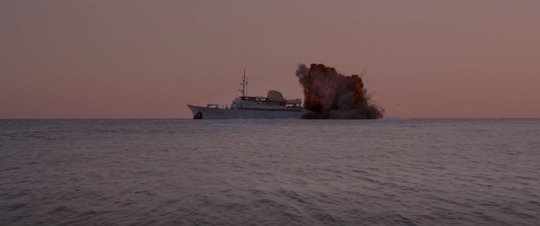

How people perceive themselves is nothing that interests me. There are very few that are gonna look in the mirror and say: The person I see is a savage monster. Instead, they make up some construction that justifies what they do.
And there it is. You're rich, so you're a philanthropist, so you can cure your conscience for not paying enough in tax. Not contributing enough to society.
And I recall, I was seven years old walking into the kitchen to find my mother crying inconsolably. Martin Luther King had been shot. Two months later, she was crying again. Bobby Kennedy was killed. I couldn't know then what I know now, that the invisible thread connecting Martin Luther King, the Kennedy brothers, and Malcolm X, was that in each case, my government had their finger on the trigger.
My government murdered Martin Luther King, Malcolm X, Bobby Kennedy and John F. Kennedy. My government overthrew good, honest, democratic leaders of the people in Chile, Venezuela, Argentina, Peru, El Salvador, Nicaragua, Panama and Bolivia. Along with Britain, we carved up the Middle East, creating artificial geological boundaries and installing puppet dictators. War itself became our most lucrative industry. Every bomb that is dropped makes somebody millions of dollars. You don't have to know where those bombs are exploding. You don't have to see the grieving mothers and the mangled bodies of their children.
Eugene Debs gave this speech in Canton Ohio, in 1918: "Throughout history, wars have been waged for conquest and plunder. The master class has always declared wars. The subject class has always fought. They've taught you to believe it to be your patriotic duty to go to war and to have yourselves slaughtered at their command. - Triangle of Sadness. (2022) dir. Ruben Östlund
#capitalism#socialism#poisonedsequin#fashion's equipoise#movie#film#movie quote#film quote#triangle of sadness#ruben ostlund#woody harrelson#screencaps#2022#film 2022
232 notes
·
View notes